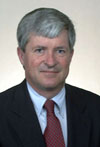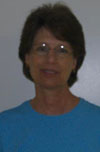Move matches PPC with sub-specialty clinics
by Michael BakerPublic Relations
With ongoing construction and expansion at MUSC forcing office and departmental relocations, the constant movement can be a hassle. But for Pediatric Primary Care, the department’s recent move from McClennan-Banks to Rutledge Tower represented a perfect match.
 Dr.
J. Routt Reigart
Dr.
J. Routt Reigart
The relocation places the clinic in the same building as many of the pediatric specialty clinics, localizing patient care. The tightly knit group of general and special pediatric services has drawn rave reviews from J. Routt Reigart, M.D., director of general pediatrics.
“The proximity to other pediatric sub-specialists is the most important aspect of our new location,” he said. “For example, if a patient presents a surgical problem, pediatric surgery is right upstairs.” Similarly, the Rutledge Tower pharmacy and radiology lab reside within two floors of the primary care clinic.
According to Reigart, the clinic’s new location allows it to integrate its services with the other clinics.
“When a patient enters our system, the new physical layout makes access to and familiarity with MUSC’s environment much easier,” he explained. “It highly integrates care for patients with general and specialized pediatric needs.”
Sue White, R.N., clinical care coordinator, agreed.
 Sue
White
Sue
White
“On the third floor alone, we have four specialized clinics, and there are 16 on the fourth floor,” she said. “All pediatric clinics except cardiology are located within three floors of Pediatric Primary Care.”
“We offer sort of a one-stop shop for primary and specialized care,” Reigart concluded.
Reigart said that as general pediatricians, he and his fellow faculty value the clinic’s role as coordinator of care for pediatric patients. Part of the coordination process involves continuity of care, which the clinic addresses by assigning every patient to a specific clinical provider who will be a faculty member, pediatric resident or pediatric nurse clinic practitioner.
Within the Resident Continuity system, patients receive continuous care from an assigned resident for the three years of the physician’s residency. The Faculty Practice system assigns a pediatric faculty member to each patient as a primary care provider.
In both systems, patients receive continuous, personal care. Thus, the patient feels more comfortable dealing with a single physician rather than with an ever-changing group of primary care providers. Also, the physician gains a greater understanding of the patient’s health history, since he/she generally serves as the patient’s main provider of primary care.
Furthermore, if patients need to be admitted to the Children’s Hospital, their physicians follow them, providing primary care in the hospital setting.
“All of our attending physicians are excellent,” Reigart said. “Of the eight in our clinic, four have been listed among the best doctors in the nation almost every year. I don’t think any other practice can say that.”
Reigart and White both added that an exceptional group of nurses fortifies the clinic. “The patients love our nurses,” they agreed. “We have a wonderful staff.”
The clinic also coordinates patient care through its computerized record system. With computers in the nursing station and every examination room, physicians and nurses have each patient’s medical records at their fingertips.
“We’re basically a paperless office,” Reigart said. “Patient records, lab results, and medication lists are available to every provider in our system, which means we know everything about each patient’s history of care. Thus far, it’s been a seamless system.”
Avoiding the confusion and hassle of paperwork allows physicians and nurses to spend extra time with their patients. According to Reigart, many private practices devote an average of only six to seven minutes to each patient during an office visit. Ongoing time studies from the MUSC clinic show that time with physicians in Rutledge Tower lasts from 15 to 30 minutes.
The extra time spent with each patient paid noticeable returns. Patients who returned satisfaction reports to the clinic consistently gave high ratings to the quality of care.
“Since we moved in October, the satisfaction ratings have been on par with or above those of all other clinics in Ambulatory Care Services,” Reigart said. A chart of the responses indicates that in many categories, 95 percent of the patients were completely satisfied with the level of care provided by the clinic.
Rather than being satisfied with such high marks, the clinic continues to use time studies to improve its services.
“We’re analyzing each step of the care process to see how we can improve certain areas,” Reigart explained. “We want to know where our physicians and nurses spend most of their time and why.”
Time studies, continuity of care, and well-trained employees are tools that Reigart hopes will convey the clinic’s dedication to quality pediatric health care.
“I encourage the university and the community to visit us at our new
location,” Reigart concluded. “Being here gives us a huge advantage in
patient care.”
Friday, June 11, 2004
Catalyst Online is published weekly, updated
as needed and improved from time to time by the MUSC Office of Public Relations
for the faculty, employees and students of the Medical University of South
Carolina. Catalyst Online editor, Kim Draughn, can be reached at 792-4107
or by email, catalyst@musc.edu. Editorial copy can be submitted to Catalyst
Online and to The Catalyst in print by fax, 792-6723, or by email to petersnd@musc.edu
or catalyst@musc.edu. To place an ad in The Catalyst hardcopy, call Community
Press at 849-1778.